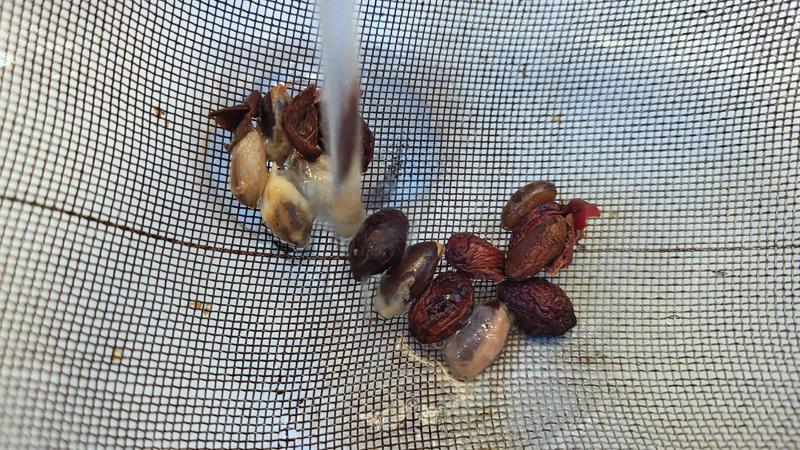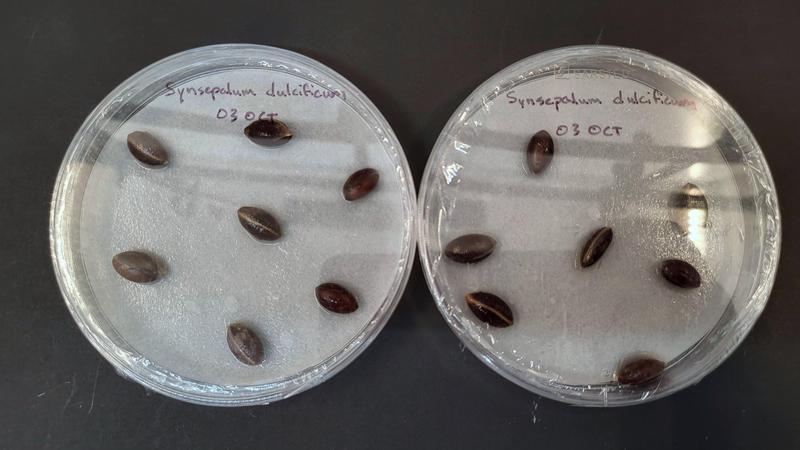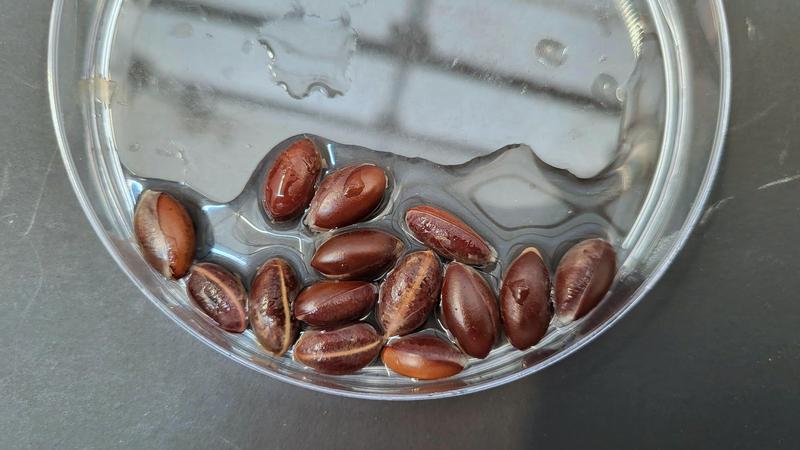Synsepalum dulcificum
Propagation
The average time to reproductive maturity is greater than 36 months. However, adequate watering can reduce this to an average of 23 months.[1]
Hermaphrodite and autogamous flowers.[2]
Germination
| media | germination | temperature °C | note | reference |
|---|---|---|---|---|
Highly recalcitrant seeds. Dulcificum seeds do not tolerate storage of any kind including desiccation or cold. Germination capacity is entirely lost after 28 days at room temperature (the best scenario). It is still unknown whether cryopreservation is possible.[3]
Green fruits exhibit lower germination (19%) than red (95%) or yellow (85%) fruits. Red fruited seed viability is 99% at the time of fruit shedding (36.6% moisture content). Viability decreases to 49% at 20% moisture content and 0% below 10% moisture content. Germination rates follow a similar trend with only 50% germination at 24.5% moisture.[3]
Similarly, storage at low temperatures rapidly decreases germination. Half viability occurs with storage at 4°C in 7 days while storage at 25°C retains half viability at 21 days. Seedlings that result from cold-stored seeds had an overall reduced growth after sixty days.[3]
However, drying for 1 day at room temperature simplified the removal of the seed coat, decreasing the contamination rate and improving the seedling growth rate.[4]
Seed disinfection with sodium hypochlorite or sodium dichloroisocyanurate reduced the germination rate and in the case of NaDCC, actually increased the total infection rate. Disinfection with 3% hydrogen peroxide solution for 20 minutes reduced the contamination from 13% in water controls to 6% while reducing the germination rate from 53% to 43%.[4]
Germination is maximal at 30°C incubation compared to either 23°C or 37°C.[4]
An older study found that incubation at 18°C had a similar germination rate as incubation at 28°C but in half the time (15 days vs. 27 days). Incubation at 30°C resulted in 89% germination in 27 days. However, the “results are not conclusive since they are not from a statistically designed experiment…” according to the authors.[5]
Vegetative
Cuttings take a long time to root, according to one (non-peer-reviewed) source.[6] However, this has yet to be tested directly.[2]
In-Vitro
| basal media | supplements | source | target | note | reference |
|---|---|---|---|---|---|
Cultivation
| Planting density (m-2) | inter-row space (cm) | intra-row space (cm) | note | reference |
|---|---|---|---|---|
A tropical plant that prefers a warm, humid climate free from frost. Can survive in full sun but prefers partial shade in acid soil.[7]
Harvest
Yield
| product | source | yield per season (kg/ha) | note | reference |
|---|---|---|---|---|
| product | source | yield per plant | note | reference |
|---|---|---|---|---|
Soilless
Soil
| soil type | pH | C-content % | precipitation | temperature (°C) | altitude (m) | note | reference |
|---|---|---|---|---|---|---|---|
Fertilization
| type | rate | time | note | reference |
|---|---|---|---|---|
Potassium sulfate, triple super phosphate, and urea can be used to fertilize dulcificum. However, seedlings are sensitive to urea in isolation: only 10% of seedlings survive a 3g dose compared to 80% at 1.5g and 90% at 0g (nonsignificant difference). Similarly, no seedlings survive a 4.5g dose. Potassium sulfate and TSP in isolation have similar survival rates across 0-4.5g dosages.[1]
A combination NPK fertilizer (1.5g each of urea, TSP, potassium sulfate) was effective at increasing various growth parameters. Stem collar diameter, branching, height, leaf production, leaf area, bud number, flowering percentage, and cumulative fruit number were increased with NPK application compared to controls and/or single fertilizer application. Similarly, NPK was effective at reducing the time to flowering and time to fruiting.[1]
Potassium specifically was effective at decreasing the time to flowering and increasing fruit mass.[1]
However, water supply seems to be the primary determining factor for inducing the reproductive phase. Simple daily watering can reduce the juvenile phase from >36 months in natural conditions to 21 months. Furthermore, fruit production is five-fold higher with NPK application compared to just watering.[1]
Temperature
Lighting
| fixture type | photoperiod | illumination | note | reference |
|---|---|---|---|---|
Pests
No significant pests have been noted.[6]
Morphology
| character | measurement | unit | notes | reference |
|---|---|---|---|---|
An evergreen shrub growing up to 4m tall.[2]
Names
- Bumelia dulcificum Schumacher, 1827[2]
- Sideroxylon dulcificum Candolle, 1844[2]
- Bakeriella dulcifica (Schumach. & Thonn.) Dubard[7]
- Pouteria dulcifica (Schumach. & Thonn.) Baehni[7]
- Synsepalum glycydora Wernham.[7]
Roots
Stem
Leaves
Leaves are entire, alternate, symmetrical, and obovate-lanceolate to broadly lanceolate and pointed at apex, with 4.3–7.5 cm long and 3.1–3.8 cm in width. The length/width ratio is 2:1. The apex in itself is obtuse and is occasionally slightly acuminate. The adaxial surface of the leaves is glabrous and the abaxial surface is pubescent. Leaves are characterized by glands absence and are grouped around a branch to which they are inserted through a very short petiole (4–5 mm in length). The abaxial leaf epidermis is heavily covered with very thick-walled two-armed hairs.[2][8]
Inflorescence
Flowers are bisexual, white, small, solitary or in small clusters… The calyx consists of 4–5 sepals, the corolla with 4–5 petals, and the androecium with five stamens. Within the gynoecium, the style is simple, erect with a very inconspicuous stigma. The ovary is superior with the outer wall heavily covered with hairs.[2][8]
Flowers are produced continuously or semi-continuously when conditions are optimal, most especially water supply.[9][2][1]
Seeds
Fruit is an ovoid to oblong berry (Figs. 3 and 4), 2–2.5 cm long, 1 cm wide, finely pubescent, with a persistent protruding style, green turning to bright red when ripe…[2]
At time of (red) fruit shedding, seeds have an average mass of 194.4 ± 1.8 mg with a moisture content of 36.6 ± 0.79%.[3]
Fruits mature 35-40 (green), 60-65 (yellow), and 70-74 (red) days after flower bloom.[3]
Phytochemistry
| compound | source | concentration (mg/g dry weight) | note | reference |
|---|---|---|---|---|
The plant is most famous for the sweetening effect of its fruit. A glycoprotein called miraculin binds to the sweet taste receptors rendering many traditionally sour tasting foods (acid) to be perceived as sweet.[10][11]
Infraspecific Variation
Biosynthesis
Distribution
Timecourse
Improvement
| trait | improvement status | reference |
|---|---|---|
Identification
| variety | description | reference |
|---|---|---|
Germplasm resides almost entirely in home gardens and stands on seed farms. Wild stands exist but are not well characterized.[2]
Inheritance
Methods
| type | note | reference |
|---|---|---|
Flowers are hermaphroditic and must be emasculated for outcrossing success.[9]
History & Society
Work Log
04 Oct 2022
Unsurprisingly, contamination. I wish I had processed the seeds when they first arrived.
Washed seeds with soap and running water. Cracked and removed the seed coat on half of the seeds. Disinfected the other half with 2-3% hydrogen peroxide (old concentrate bottle, diluted) for 20 min. Placed both on new filter paper in Petri dishes and returned to the incubator.
03 Oct 2022
Processed the seeds today. Removed the fruit and pulp under running water. Sowed without disinfection on filter paper. Incubated at 30°C with 16-hour photoperiod.
https://www.miraclefruitfarm.com
29 Sep 2022
Received 14 seeds today from a Redditor. They are a little dry, but it good condition. Unfortunately, I am leaving for the weekend and can’t sow them until after I return.
Bibliography
-
Tchokponhoué, Dèdéou Apocalypse and N'Danikou, Sognigbé and Hale, Iago and Van Deynze, Allen and {Achigan-Dako}, Enoch Gbènato, Early Fruiting in Synsepalum Dulcificum (Schumach. \& Thonn.) Daniell Juveniles Induced by Water and Inorganic Nutrient Management, F1000Research, vol. 6, pp. 399, March 2017.
doi: 10.12688/f1000research.11091.1.
Background. The miracle plant, Synsepalum dulcificum (Schumach. \& Thonn.) Daniell is a native African orphan crop species that has recently received increased attention due to its promise as a sweetener and source of antioxidants in both the food and pharmaceutical industries. However, a major obstacle to the species’ widespread utilization is its relatively slow growth rate and prolonged juvenile period. Method. In this study, we tested twelve treatments made up of various watering regimes and exogenous nutrient application (nitrogen, phosphorus and potassium, at varying dosages) on the relative survival, growth, and reproductive development of 15-months-old S. dulcificum juveniles. Results. While the plants survived under most tested growing conditions, nitrogen application at doses higher than 1.5 g [seedling] -1 was found to be highly detrimental, reducing survival to 0\%. The treatment was found to affect all growth traits, and juveniles that received a combination of nitrogen, phosphorus, and potassium (each at a rate of 1.5 g [seedling] -1), in addition to daily watering, exhibited the most vegetative growth. The simple daily provision of adequate water was found to greatly accelerate the transition to reproductive maturity in the species (from {$>$}36 months to an average of 23 months), whereas nutrient application affected the length of the reproductive phase within a season, as well as the fruiting intensity. Conclusions. This study highlights the beneficial effect of water supply and fertilization on both vegetative and reproductive growth in S. dulcificum. Water supply appeared to be the most important factor unlocking flowering in the species, while the combination of nitrogen, phosphorus and potassium at the dose of 1.5 g (for all) consistently exhibited the highest performance for all growth and yield traits. These findings will help intensify S. dulcificum’s breeding and horticultural development.
-
{Achigan-Dako}, Enoch G. and Tchokponhoué, Dèdéou A. and N’Danikou, Sognigbé and Gebauer, Jens and Vodouhè, Raymond S., Current Knowledge and Breeding Perspectives for the Miracle Plant Synsepalum Dulcificum (Schum. et Thonn.) Daniell, Genetic Resources and Crop Evolution, vol. 62, no. 3, pp. 465--476, March 2015.
doi: 10.1007/s10722-015-0225-7.
Synsepalum dulcificum, an African native shrub, is a valuable species. All plant parts are of medicinal importance whereas the fruit known as magic berry, miracle berry, or sweet berry is consumed fresh. Surprisingly, very little is known on the species in terms of genotypes utilization and breeding. In this review we recalled the uses and importance of the species and suggested research avenues for an accelerated growth and fruit production. Synsepalum dulcificum is rich in glycoprotein and is an excellent natural sweetener and also a good candidate for the synthesis of drugs against diabetes. Furthermore, S. dulcificum has high content in phytochemical substances (e.g. (+)-epi-syringaresinol, vanillic acid, cyanidin-3-monogalactoside, and quercetin-3-monogalactoside) with various health and food benefits. Data on the nutrient content are limited. Likewise, knowledge on the reproductive biology and mating system is still narrow, combined with poorly developed horticultural practices. To fully exploit the potential of S. dulcificum prospective actions include: (1) improving the propagation and growth abilities of the species, (2) improving knowledge of floral biology and genetic diversity, (3) understanding the phenological phases of the species, gene expressions and how this contributes to metabolites accumulation and (4) improving genotypes for beverages, cosmetics and pharmaceutical industries and other value chains.
-
Tchokponhoué, Dèdéou Apocalypse and N’Danikou, Sognigbé and {Achigan-Dako}, Enoch Gbènato, A Combination of Approaches Evidenced Seed Storage Behaviour in the Miracle Berry Synsepalum Dulcificum (Schumach. et Thonn.) Daniell, BMC Plant Biology, vol. 19, no. 1, pp. 117, March 2019.
doi: 10.1186/s12870-019-1714-1.
Knowledge on seed storage behaviour is crucial for planning conservation strategies of plant genetic resources particularly in economically promising but endangered species like Synsepalum dulcificum, viewed as recalcitrant-seeded species albeit sound evidence was lacking. In this study, we combined an experimental approach based on critical moisture content and storage environment analysis, and the seed-coat ratio–seed dry mass (SCR-SM) model to clarify the seed storage behaviour in the species. Seed moisture content at shedding was determined and effects of dehydration and cold storage on seed viability, germination and subsequent seedling vigour were analysed. The probability for dessication-senstivity [P(D-S)] was also determined.
-
Chambers, Alan and Demesyeux, Lynhe and Moon, Pamela and Fu, Yuqing, Optimization of Miracle Fruit (Synsepalum Dulcificum) Seed Germination and Mutagenesis, African Journal of Food Science and Technology, vol. 09, no. 02, 2018.
doi: 10.14303/ajfst.2018.231.
Interest in miracle fruit for reducing sugar content in food and beverages is increasing, but miracle fruit genetic improvement is hindered by delayed seed germination, slow seedling growth, and a lack of readily available genetic diversity. Preliminary studies were conducted to optimize the effects of seed surface sterilization, drying time, incubation temperature, and the presence or absence of the seed coat on miracle fruit germination. Optimal 10 days germination rates and seedling growth were realized by omitting surface sterilization, decreasing postharvest drying time, incubating at 30°C, and removal of the seed coat. Removal of the seed coat alone increased germination by 53\% after ten days under optimal conditions. Root and shoot lengths were maximized at 8.73 mm and 2.87 mm, respectively, after 10 days incubations under optimal conditions. Experiments using γ-ray mutagenesis were conducted as a means to create genetic diversity in this species. Irradiation levels from 0 to 600 Gy resulted in a calculated LD50 at \textasciitilde 70 Gy with total seed mortality at 400 Gy. Finally, the frequency of seeds with three cotyledons and double seeds (3.8\% and 0.43\%, respectively) were observed in multiple harvests. These findings describe conditions that increase germination percentage, maximize seedling growth rate, and establish a range of radiation levels to create miracle fruit mutation populations for the genetic improvement of this valuable species.
-
Adansi, M.A. and Holloway, H.L.O., Germination of Seeds of the Sweet or Miraculous Berry (Synsepalum Dulcificum (Schum \& Thonn.) Daniell, Acta Horticulturae, no. 53, pp. 181--182, April 1977.
doi: 10.17660/ActaHortic.1977.53.24.
Synsepalum dulcificum Schum \& Thonn. (Sweet or Miraculous berry) seeds were germinated in polyethylene bags without soil. The germination period was 27 days at 28–30°C, and 15 days at 18°C.
-
Joyner, Gene, The Miracle Fruit, Quandong West Australian Nut \& Tree Crop Association, vol. 32, no. 1, pp. 15, 2006.
url: http://wayback.archive-it.org/1941/20100524190023/http://www.wanatca.org.au/Q-Yearbook/Q06-1.pdf.
Miracle fruits truly are amazing. They really do make sour things taste sweet, and while you are under their influence, you realise just how much sugar blunts the true flavour of the sour fruit you are eating. But, a word of warning - that sour fruit is still very acidic, and will severely irritate the mucous membranes of your mouth if you eat too much and don’t rinse the acid away. Personal experience speaking here! (Pat)
- Lim, T. K., Synsepalum Dulcificum, pp. 146--150, 2013. doi: 10.1007/978-94-007-5628-1_26.
-
AYENSU, EDWARD S., Morphology and Anatomy of Synsepalum Dulcificum (Sapotaceae), Botanical Journal of the Linnean Society, vol. 65, no. 2, pp. 179--187, April 1972.
doi: 10.1111/j.1095-8339.1972.tb00932.x.
The morphology and anatomy of Synsepalum dulcificum has been described, principally because of enquiries from pharmaceutical industries considering this species as a potential replacement of the sweetening agent cyclamate. With the aid of a stereoscan and the light microscope, the pollen grains have been studied for the first time. The grains have either three, four or five colpi. The exine has two well-defined layers. The scanning electron microscope has revealed a very fine striate-granular pattern on the sexine. The importance of leaf venation in the classification of the Sapotaceae has been emphasized in a detailed description of Synsepalum dulcificum: The need for further studies has been noted.
-
Lokossou, Chantal and Tchokponhoué, Dèdéou and Legba, Eric and N'Danikou, Sognigbé and {Achigan-Dako}, Enoch, Tips for Successful Crosses in the Miracle Plant (Synsepalum Dulcificum (Schumach \& Thonn.) Daniell, November 2020.
Te miracle plant Synsepalum dulcifcum (Schumach \& Tonn.) Daniell, also known as Richardella dulcifca (Schumach \& Tonn.) Baehni is a West African native fruit species. It belongs to the Sapotaceae, a family with roughly forty genera and 800 species. Synsepalum dulcifcum is the most famous species of its genus owing to its fruits “the miracle berry” known as the unique natural source of miraculin, a taste modifying glycoprotein. Te sweetening property of the miracle berry placed the species as one of the most valuable and promising species in the Sapotaceae family. Te species is a good source of antioxidants and has numerous applications in food and beverages, and pharmaceutical industries.
-
Koizumi, Ayako and Tsuchiya, Asami and Nakajima, Ken-ichiro and Ito, Keisuke and Terada, Tohru and {Shimizu-Ibuka}, Akiko and Briand, Loïc and Asakura, Tomiko and Misaka, Takumi and Abe, Keiko, Human Sweet Taste Receptor Mediates Acid-Induced Sweetness of Miraculin, Proceedings of the National Academy of Sciences of the United States of America, vol. 108, no. 40, pp. 16819--16824, October 2011.
doi: 10.1073/pnas.1016644108.
Miraculin (MCL) is a homodimeric protein isolated from the red berries of Richadella dulcifica. MCL, although flat in taste at neutral pH, has taste-modifying activity to convert sour stimuli to sweetness. Once MCL is held on the tongue, strong sweetness is sensed over 1 h each time we taste a sour solution. Nevertheless, no molecular mechanism underlying the taste-modifying activity has been clarified. In this study, we succeeded in quantitatively evaluating the acid-induced sweetness of MCL using a cell-based assay system and found that MCL activated hT1R2-hT1R3 pH-dependently as the pH decreased from 6.5 to 4.8, and that the receptor activation occurred every time an acid solution was applied. Although MCL per se is sensory-inactive at pH 6.7 or higher, it suppressed the response of hT1R2-hT1R3 to other sweeteners at neutral pH and enhanced the response at weakly acidic pH. Using human/mouse chimeric receptors and molecular modeling, we revealed that the amino-terminal domain of hT1R2 is required for the response to MCL. Our data suggest that MCL binds hT1R2-hT1R3 as an antagonist at neutral pH and functionally changes into an agonist at acidic pH, and we conclude this may cause its taste-modifying activity.
- Hamdard, Jamia and Mangla, Bharti and Kohli, Kanchan, Pharmaceutical and Therapeutic Potential of Miraculin and Miracle Berry, Tropical Journal of Natural Product Research, vol. 2, no. 1, pp. 12--17, January 2018. doi: 10.26538/tjnpr/v2i1.3.




